Clicking on the images will display a larger version.
Clicking again will close the window. Where an 'X' shows bottom right
of the image, click on this (or use the 'f' key) to display full size.
(You may wish to maximise your screen for this).
|
| Royal Aircraft Factory SE5A |
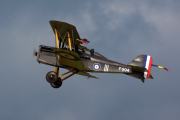
RAF SE5A
One of the foremost British fighters of WW1 was the SE5A. 92 Squadron
used theirs to great effect over the Western Front from July 1918 until the
Armistice. F904 of the Shuttleworth Collection carries the WW1 area
markings of 92 Squadron. Photographed at Old Warden on 2nd September 2012.
Photograph: Ian Bowskill Collection.
|
|
|
|
|
|
|
|
|
|
| Supermarine Spitfire |
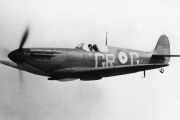
Mk 1a P9372 Spring 1940
An early photo of a 92 Squadron Spitfire Mk1a. The GR codes date it to
the Spring of 1940 and the lack of an armour plated windscreen dates it to
pre Dunkirk. P9372 was shot down over Rye in September 1940. The wreck was
recovered in relatively recent times and in spite of much of it being on
display on the wall in the Biggin Hill Heritage Hangar, it is under rebuild
to flying condition.
Photographer unknown.
|
|
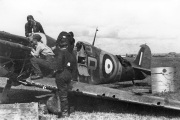
Mk1a R6597 GR-A 1940
Ground crew attend to Spitfire Mk.1a R6597 GR-A after a landing accident
at RAF Pembrey in July 1940. The pilot was Sgt Ronnie Fokes returning from
a night sortie and the port undercarriage leg collapsed. She was operational
again later that day. The gun patches show that the guns had been fired.
Photograph: RAF Museum (photographer unknown.)
| |
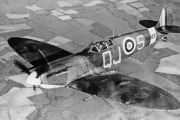
Mk Vb R6923 QJ-S in 1941
Alan Wright at the controls of Mk Vb R6923 QJ-S in 1941.
Photograph: Charles E. Brown.
|
|

R6923 QJ-S in 1941
Alan Wright at the controls of Spitfire Mk.Vb R6923 sometime in 1941.
Photograph: Charles E. Brown.
| |
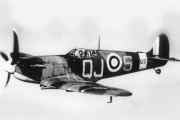
R6923 QJ-S in 1941
Alan Wright at the controls of Spitfire Mk.Vb R6923 sometime in 1941.
Photograph: Ian Bowskill Collection.
|
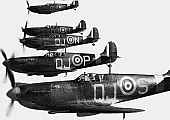
Spitfires, 1941
A formation of 92 Squadron Spitfire Mk.Vb aircraft taken in the first
half of 1941. The aircraft nearest the camera, R6923, was built as a Mk.1 and
converted to a Mk.V prior to delivery to 92 Squadron on 26th November 1940. It
remained on strength until being ditched in the sea following combat with a Messerschmitt Bf109 on 22nd June 1941. The pilot flying R6923 at the time this picture was taken was probably Flying Officer Alan Wright. Alan is an Honorary Member of The Battle Of Britain Locomotive Society.
Photograph: Ian Bowskill Collection.
|
|
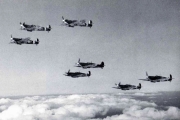
Spitfires, 1941
Seven Mk.Vb Spitfires return from a sortie sometime in 1941. Allan Wright
leads the topmost section in R6923/QJ-S.
Photographer unknown.
|
|
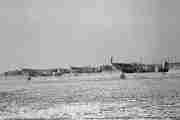
Manston, February 1941
92 Squadron Spitfires taking off from RAF Manston in February 1941.
Photographer unknown.
|
|
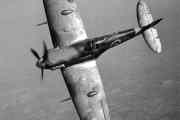
Spitfire MkVb, 1941
MkVb Spitfire R6923 QJ-S shows its topside to the camera somewhere over
southern England in May 1941. The aircraft was shot down into the sea on
22nd June 1941.
Photograph: RAF Official.
|
|
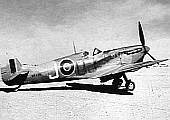
Spitfire MkVc, N.Africa, 1942
BR476 QJ/J. A Spitfire Mk.Vc (Trop) at an airfield somewhere in North
Africa in late 1942.
Photograph: Ian Bowskill Collection.
|
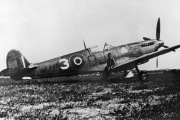
Spitfire MkVIII, 1944
JF587/QJ-3 at an airfield somewhere in Italy in 1944. The aircraft is an
LF (low level fighter) MkVIII and still carries the triangular Desert Air
Force badge ahead of the cockpit. It was struck off charge on 26th April
1945.
Photograph: E Barnes.
|
|
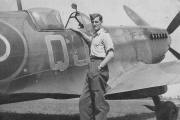
Spitfire in Austria
The red, outlined white, squadron code letters would indicate this is was
taken either very late in WW2 or in early postwar days by which time 92
Squadron Spitfires were carrying grey/green camouflage rather than the desert
scheme. It is in all probability a Mk.VIII Spitfire as 92 Squadron had
relinquished the visually similar Mk.IX variant well before the end of the
Italian campaign.
Photograph: by kind permission of S E Kirkham.
|
|
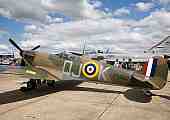
Spitfire MkIIa, 2010
As part of the Battle of Britain 70th anniversary celebrations, the RAF
Battle of Britain Memorial Flight has painted its Mk.IIa Spitfire in 92
Squadron markings. A Battle of Britain veteran itself, P7350 carries the
markings of Geoff Wellum's aircraft.
Geoff is an honorary member of BBLS and was both the first wartime trained and
youngest pilot to serve in the Battle of Britain. Being the youngest pilot on
92 Squadron at the time he was not surprisingly given the nickname "Boy".
Photograph: Ian Bowskill.
|
|
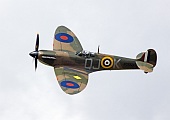
Spitfire MkIIa, 2010
Another shot of the BBMF Mk.IIa Spitfire carrying the 92 Squadron
markings of Geoff Wellum. Photographed at Duxford on 16th May 2010.
Photograph: Ian Bowskill.
|
|
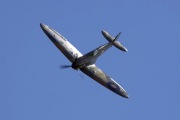
Spitfire P9374
Spitfire MK.1a P9374/J was on strength with 92 Squadron on the run up to
the Dunkirk evacuation. On 23rd May 1940 92 Squadron took off from RAF
Hornchurch to intercept German bombers attacking British and French troops
in the Dunkirk area. Peter Cazenove was the pilot of P9374 that day.
In an attack on a German formation the aircraft suffered engine damage and Peter
had to force land on the beach at Calais. The Germans showed no interest in
recovering it and over time P9374 sank into the sands. In 1980 the tides and
shifting sands brought P9374 to the surface again and the long task of recovering
her began. After an expensive and painstaking rebuild P9374 flew again some 31
years after being rediscovered. She is seen here at Duxford on August 5th 2012.
Photograph: Ian Bowskill.
|
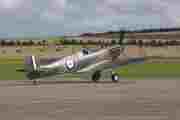
Spitfire P9374
Another view of P9374 at Duxford on August 5th 2012.
Photograph: Ian Bowskill.
|
|
|
|
|
|
|
|
|
|
| Gloster Meteor |
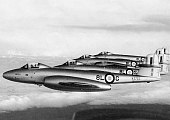
Meteor F8s, 1950
A flight of Gloster Meteor F8s taken in late 1950, soon after 92 Squadron
had received the type. The aircraft are carrying the short lived 8L squadron
codes which were replaced by the more familiar red and yellow checks soon
after this picture was taken.
The picture has been made available by Brian Lamb, who was a pilot on 92 at the time.
|
|
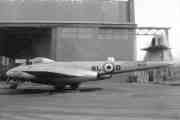
Meteor F8 WA815/8L-D, 1950
Carrying the short lived 8L squadron codes, Gloster Meteor F8 WA815/8L-D
is seen outside a hanger in 1950. Probably at RAF Linton On Ouse, 92's
home base at the time.
Photograph: Ian Bowskill collection.
|
|
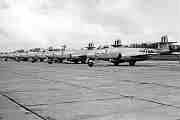
Meteor line-up, 1951-4?
WA763/G at the end of a line up of Gloster Meteor F8 jets, probably at
the Squadron's home base of Linton on Ouse. The red and yellow checks
on the fuselage date it to between April 1951 when they superseded 92's
8L codes and 1954 when the Squadron relinquished the Meteor in favour of the
Sabre.
Photographer unknown.
|
|
|
|
|
|
| Canadair Sabre |
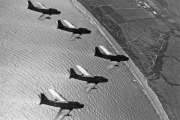
Sabres over Yorkshire, 1954
92 Squadron was one of only two squadrons to fly the Sabre F4 in RAF
Fighter Command. A flight comes in over the Yorkshire coast en route to home
base at RAF Linton-on-Ouse in 1954.
Photograph: RAF.
|
|
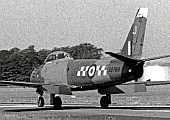
Sabre F4, Hooton Park 1955
92 Squadron's Canadair CL-13 Sabre Mk4 XD769/J taxies out at RAF
Hooton Park to display for assembled members of the Royal Observer Corps.
24th July 1955.
Photograph by kind permission of R.A. Scholefield.
|
|
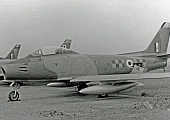
Sabre F4, Ringway 1955
Canadair Sabre F4 XD728 at Ringway on 30th October 1955.
Photograph by kind permission of R.A. Scholefield.
|
|
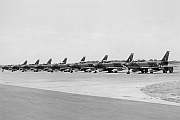
Sabre F4s, Linton on Ouse
Sabre F4 flight line at RAF Linton on Ouse in 1955.
Photograph: R. L. Ward.
|
|
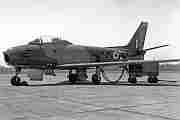
Sabre F4, Linton on Ouse
Sabre F4 XD766 at RAF Linton on Ouse c.1955.
Photographer unknown.
|
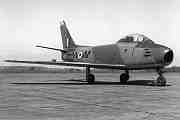
Sabre F4, Linton on Ouse
Sabre F4 XD734 at RAF Linton on Ouse c.1955.
Photographer unknown.
|
|
|
|
|
|
|
|
|
|
| Hawker Hunter |
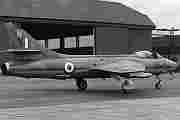
Hawker Hunter F4 c.1956
Hawker Hunter F4 XF516 c.1956. Location and exact date not known.
Photographer unknown.
|
|
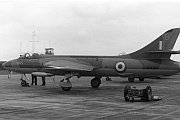
Hawker Hunter F4 c.1956
Hunter F4 WV314 on show c.1956. Exact date and location not known.
Photographer unknown.
|
|
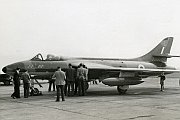
Hawker Hunter F6 c.1959
Hunter F6 XE532 on show at an RAF Battle of Britain "At Home"
day on 19th September 1959. Location not known.
Photographer unknown.
|
|
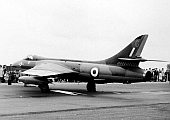
Hawker Hunter F6, Gaydon
Hawker Hunter F6 XG232/G of 92 Squadron on show at the RAF Gaydon Battle
of Britain display on 17th September 1960.
Photograph by kind permission of Peter Clarke.
|
|
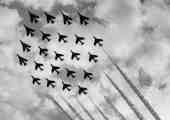
Blue Diamonds, Farnborough
The 16 Hawker Hunters of the Blue Diamonds in formation with 7 English
Electric Lightning F1s as they give a joint display at the SBAC Farnborough show in 1962.
Photograph: Ian Bowskill Collection.
|
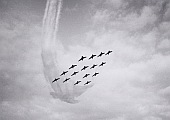
Blue Diamonds, Farnborough
The Blue Diamonds. 16 Hunters in immaculate formation. A lone two seat T7
(probably XL571/V) leads 15 single seat F6 at the SBAC Farnborough show on 8th September 1962.
Photograph by kind permission of George Trussell.
|
|
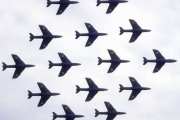
Blue Diamonds, Farnborough
With their Hunter T7 leading, the Blue Diamonds fly past in a Diamond 16
formation at the 1962 Farnborough air show.
Photograph: Adrian Pingstone.
|
|
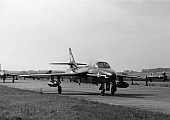
Hunter T7, Biggin Hill
Hunter T7, XL571/V leads in the "Blue Diamonds" at the end of
a display at RAF Biggin Hill. Picture thought to have been taken in 1962.
Photograph: Ian Bowskill Collection.
|
|
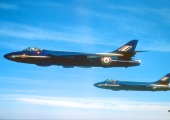
A pair of Hunter F6 aircraft
An air to air shot of a pair of Blue Diamonds Hawker Hunter F6 aircraft.
Date, location and photographer unknown but c.1962.
Photograph: Ian Bowskill Collection.
|
|
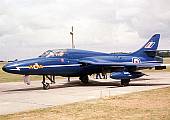
Hunter T7, Wethersfield
In the early 1960s 92 Squadron was the official RAF Fighter Command
aerobatic team. Christened the "Blue Diamonds," the Squadron's
Hawker Hunters sported a glorious blue colour scheme. So adorned, Hunter T7
XL571 poses for the camera at the RAF Wethersfield Armed Forces Day in
August 1964.
Photograph: Ian Bowskill Collection.
|
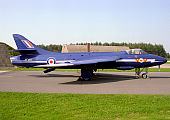
Hunter FGA9, Wildenrath
In 1985 Hunter FGA9 XF418 arrived at RAF Wildenrath for Battle Damage Repair
Training but 92 Squadron had other ideas. The aircraft was restored to a very
close approximation of the blue livery carried by 92's Hunter F6s during
the Squadron's period in the early 1960s as the Blue Diamonds aerobatic
team. The aircraft is seen on roll out on 10th September 1985.
Photograph: Ian Bowskill.
|
|
|
|
|
|
|
|
|
|
| English Electric Lightning |
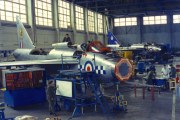
A pair of F2 Lightnings, 1963
A pair of F2 Lightnings undergo deep servicing at RAF Leconfield in 1963.
XN781/J from 19 Squadron in the foreground and XN798/G of 92 Squadron in the
background. "Golf" is wearing the earlier form of 92 Squadron
colours prior to the spine being painted blue also and the nose markings
gaining a white edging.
Photograph: Ian Bowskill collection.
|
|
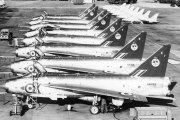
Eight Lightnings, 1964
A shot taken during the great days of the Farnborough airshow. On the left
can be seen the tails of the Jet Provosts of the Central Flying School's
Red Pelicans display team, on the right can be seen the Folland Gnats of the
4FTS Yellowjacks display team (forerunners to the Red Arrows) and taking
centre stage are no less than seven Lightning F2s and one T4 of 92 Squadron.
What a show that must have been. September 1964.
Photograph: Ian Bowskill collection.
|
|
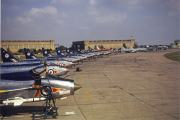
RAF Leconfield, 1964
The flight line at RAF Leconfield in October 1964. 92 Squadron's
Lightning T4 XM995 is nearest with eight of their F2s arcing away from the
camera. Next comes a Lightning T5 from 145 Sqd/226OCU with its red and white
markings and right in the background are five somewhat plainly marked
Lightning F2s of 19 Squadron.
Photograph: Ian Bowskill collection.
|
|
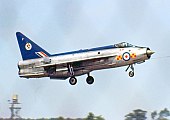
F2A at RAF Gütersloh, 1969
English Electric Lightning F2 XN769 photographed during June 1969 at 92
Squadron's then home base of RAF Gütersloh in Germany.
Photograph: Graham Dives.
|
|
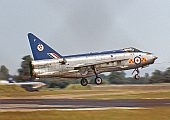
F2A at RAF Gütersloh, 1969
English Electric Lightning F2 XN769 photographed during June 1969 at 92
Squadron's then home base of RAF Gütersloh in Germany.
Photograph: Graham Dives.
|
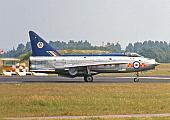
F2A at RAF Gütersloh, 1969
English Electric Lightning F2 XN769 photographed during June 1969 at 92
Squadron's then home base of RAF Gütersloh in Germany.
Photograph: Graham Dives.
|
|
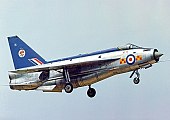
F2A at RAF Gütersloh, 1969
English Electric Lightning F2A XN782/H photographed during June 1969 at
92 Squadron's then home base of RAF Gütersloh in Germany.
Photograph: Graham Dives.
|
|
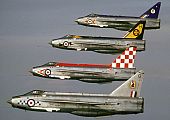
XN783 flies in formation
92 Squadron's Lightning F2 XN783 (top) flies in formation with F3s
from 111 Squadron, XP739 and 56 Squadron, XP746 and an F2 from 19 Squadron,
XN779.
Photograph: Ian Bowskill collection.
|
|
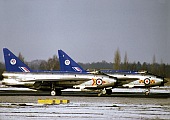
F2s, RAF Gütersloh, 1969
EE Lightning F2s XN768/S (front) and XN783/A line up for take off at RAF
Gütersloh sometime in the March or April 1969. This picture illustrates
both types of nose art carried by 92 Squadron Lightnings, that on XN768 being
the earlier style.
Photograph: Ian Bowskill collection.
|
|
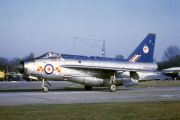
F2A, RAF Brüggen, 1970
Lightning F2A XN773/E taxis out at RAF Brüggen sometime during 1970.
92 Squadron was operating from here at the time due to runway repairs at its
home base of RAF Gütersloh.
Photographer unknown, Ian Bowskill collection.
|
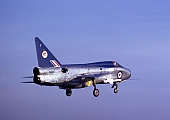
T4, RAF Gütersloh, 1970
English Electric Lightning T4 XM995/T comes in to land at RAF
Gütersloh in December 1970. The aircraft retains the blue fin and spine
but has lost the colourful nose markings.
Photograph: Ian Bowskill collection.
|
|
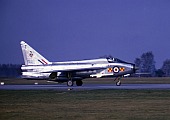
T4, RAF Gütersloh, 1971
By March 1971 T4 XM995/T had lost the blue fin and spine but gained the
later style of nose markings. Here she is seen lining up for take off at
RAF Gütersloh the same month.
Photograph: Ian Bowskill collection.
|
|
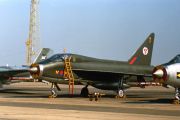
T4 RAF Coltishall, 1973
Lightning T4 XM995/T in the static lineup at the RAF Coltishall Battle
of Britain Day, 15th September 1973..
Photograph: Ian Bowskill collection.
|
|
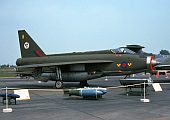
F2A, RAF Gütersloh, 1975
Lightning F2A XN727/W is wearing the olive green camouflage but has yet
to received the two blue diamonds on the tail. Believed to have been taken
at the RAF Gütersloh "Flugschau" on 6th July 1975.
Photographer unknown, Ian Bowskill collection.
|
|
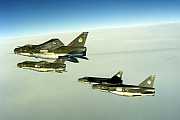
F2A Lightnings, mid 1970s
F2A Lightnings XN730/J , XN732/R, XN775/B and an unidentified example make
up a four ship somewhere high over Germany in the mid 1970s.
Photograph: 92 Squadron.
|
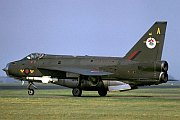
F2A, RAF Gütersloh, c.1976
Lightning F2A XN778/A was Wing Commander Ed Durham's personal aircraft
and carried "King Cobra" adornments to signify this. She's seen
here at 92's home base of Gütersloh c.1976.
Photographer unknown.
|
|
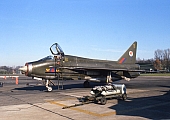
T4, RAF Gütersloh, c.1976
By the mid 1970s the RAF Germany Lightnings had received olive green
camouflage to their upper surfaces. 92 Squadron added two blue diamonds just
under the squadron crest on the tail as a subtle reference to the days when
the Squadron was the "Blue Diamonds" aerobatic team. T4 XM995/T is
seen wearing this final livery variation at Gütersloh c.1976.
Photograph: Ian Bowskill collection.
|
|
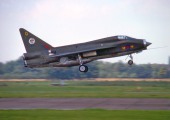
T4, RAF Gütersloh, 1976
English Electric Lightning T4 XM968/Q comes in to land at RAF
Gütersloh on 16th August 1976. The aircraft is wearing the toned down,
drab green colour scheme but as a reminder of 92's days as the Blue
Diamonds aerobatic team, two blue diamonds are painted beneath the tail
insignia.
Photograph: Ian Bowskill collection.
|
|
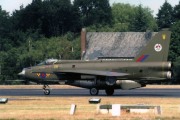
F2A, RAF Gütersloh, c.1976
Lightning F2A XN727/W about to start its takeoff run at RAF
Gütersloh c.1976.
Photograph: Ian Bowskill collection.
|
|
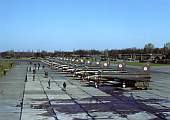
The King Cobras, 1977
92 Squadron's Lightnings line up prior to taxying out at RAF Gütersloh.
Close study of the tail codes will reveal that they spell out "The King
Cobras XV". Photo believed to have been taken on or just before 1st April
1977 when 92 Squadron relinquished the Lightning in favour of the Phantom.
Photograph: Terry Panopalis collection.
|

RAF Gütersloh, 1977
92 Squadron aircrew at RAF Gütersloh in early 1977.
Left to right: Tim Neville, Dick Gingell, Simon Morris, Roger McGowan, Kevin
Mason Pete Boothroyd, Jim Wild, Wg Cdr Ed Durham - Squadron Commander, Sqn Ldr
Mike Lawrence - A Flight Commander, Ces Ilsley, Ian Burns, Paul Carol, Roger
Malcolm, Mark Eynaud, Phil Owen, Pete Stone.
Photograph: Ian Bowskill collection.
|
|
|
|
|
|
|
|
|
|
| McDonnell Douglas Phantom |
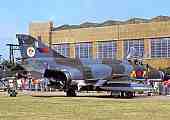
F4, RAF Finningley, 1977
Phantom F4 XV499 taken at the Queen's Silver Jubilee Review at RAF
Finningley, 1977.
Photograph: Graham Dives.
|
|
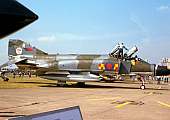
F4, RAF Finningley, 1977
Phantom F4 XV499 taken at the Queen's Silver Jubilee Review at RAF
Finningley, 1977.
Photograph: Graham Dives.
|
|
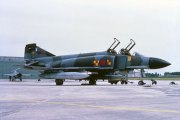
XV471/V, Wittmundhafen 1982
Still wearing the grey/green camouflage, Phantom FGR2 XV471/V rests on the
pan at the Luftwaffe's Wittmundhafen airbase in 1982. The aircraft is
still carrying the large Squadron checks on the intakes but the smaller
red/yellow checks have yet to appear on the RWR pod atop the fin. It is also
carrying the later style of emblem on the tail. This version of the Squadron
emblem was dubbed "Hissing Syd" by 92's personnel.
Photograph: Ian Bowskill collection.
|
|
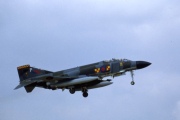
XV415, Greenham Common
Phantom FGR2 XV415 on finals to RAF Greenham Common in July 1983.
Photograph: Ian Bowskill collection.
|
|
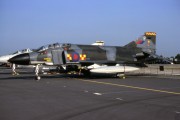
XV415, Greenham Common
XV415 all spruced up at the 1983 International Air Tattoo at Greenham
Common. Although the under wing tank is painted in "air defence
grey", the aircraft itself is still carrying the earlier grey/green
scheme along with the large squadron checks on the intakes, smaller checks
on the fin top electronics pod and "Hissing Syd" on the tail.
July 23rd 1983.
Photograph: Ian Bowskill collection.
|
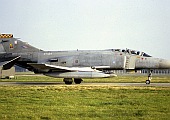
XV424/W, Coningsby, 1985
Major UK air exercises such as Elder Forest and Mallet Blow often gave
enthusiasts the opportunity to see aircraft from RAF Germany operating from
the UK. 92 Squadron's XV424/W taxis out at RAF Coningsby prior to
another mission during one such exercise in October 1985.
Photograph: Ian Bowskill.
|
|
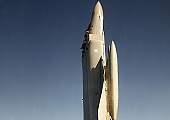
FGR2 XV480 vertical, c.1987
Phantom FGR2 XV480 goes vertical in a loop c.1987.
Photograph: Official RAF photograph.
|
|
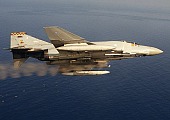
FGR2 XV480, Akrotiri, 1987
Phantom FGR2 XV480 fires its SUU-23/A 30mm cannon during an Armaments
Practice Camp at RAF Akrotiri, Cyprus in 1987. Note the spent shell cases
streaming back from the gun pod.
Photograph: Official RAF photograph.
|
|
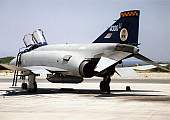
FGR2 XV498, Akrotiri, 1989
McDonnell Douglas Phantom FGR2 XV49/U at RAF Akrotiri in the summer of
1989. It is carrying short lived tail markings to mark the Squadron commander,
Wing Commander Dave Pollington's 4,000 hours on Phantoms.
Photograph: Dave Pollington, via Ian Bowskill.
|
|
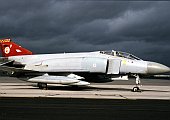
XV412/P, Brize Norton, 1990
Towards the end of the Phantom's RAF career squadrons began sporting
coloured tails reminiscent of the Lightning era. Surprisingly 92's
Phantoms sported red tails rather than the blue of their Lightnings. XV412/P
basks in the sun at Brize Norton as the storm clouds roll in on 6th October 1990.
Photograph: Ian Bowskill collection.
|
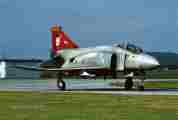
XV435 taxis, RAF Valley, 1991
XV435 taxis out on another mission during 92's final Armaments
Practice Camp as an F4 Squadron at RAF Valley. Easter 1991.
Photograph: Phil Bradshaw.
|
|
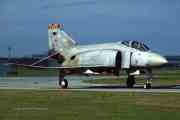
XV467 taxis, RAF Valley, 1991
XV467 taxis out on another mission during 92's final Armaments
Practice Camp as an F4 Squadron at RAF Valley. Easter 1991.
Photograph: Phil Bradshaw.
|
|
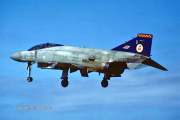
XV467 landing, RAF Valley, '91
Carrying the Wing Commander's pennant of 92's boss Wing Co Ken
Claxton, XV498 comes in to land on Runway 32 during 92's final Armaments
Practice Camp as an F4 Squadron at RAF Valley. Easter 1991.
Photograph: Phil Bradshaw.
|
|
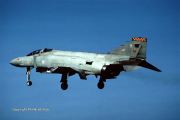
XV422 landing, RAF Valley, '91
XV422 comes in to land on Runway 32 during 92's final Armaments
Practice Camp as an F4 Squadron at RAF Valley. Easter 1991.
Photograph: Phil Bradshaw.
|
|
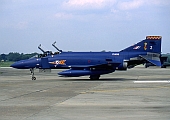
F4, RAF Fairford, 1991
In 1991 92 Squadron disbanded on the F-4 Phantom. To mark the occasion
XV408/Z was painted in an overall blue scheme reminiscent of the Squadron's
Blue Diamonds Hunters of the early 1960s. The Squadron markings on the side
also bore more than a passing resemblance to those carried by 92's F2
Lightnings. Here the aircraft is seen taxiing out at RAF Fairford on 22nd
July 1991.
Photograph: Ian Bowskill.
|
|
| BAE Hawk |
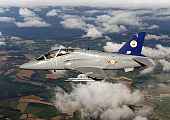
Hawk T1A XX157, N Devon
Hawk T1A XX157 flies over the North Devon countryside during 92
Squadron's time at RAF Chivenor.
Photograph: 92 Squadron via Ian Bowskill.
|
|
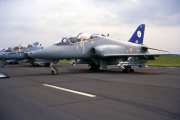
Hawk T1A XX292, 1993
April 1st 1993 saw a Royal Review at RAF Marham to celebrate the 75th
anniversary of the formation of the RAF. A full dress rehearsal took place
on March 30th and I was lucky enough to obtain passes courtesy of 92 Squadron.
A brief burst of sunshine illuminates BAe Hawk T1A XX292/R. The aircraft is
carrying its full complement of armament in the shape of a centre line gun pod
and two AIM-9L "Sidewinder" heat seeking air to air missiles.
Photograph: Ian Bowskill.
|
|
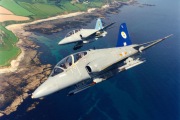
Hawk T1A XX337/K, 1993
On June 22nd 1993 XX337/K, a Hawk T1A of 92 Squadron, skirts the North
Devon coastline on a mission out of RAF Chivenor. A 19 Squadron example
trails behind.
Photograph: Rick Brewell.
|
|
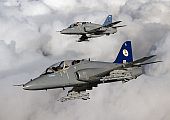
Hawk T1A XX157, 1994
Hawk T1A XX157 above the clouds and in formation with another Hawk T1A
from 19 Squadron in 1994.
Photograph: 92 Squadron via Ian Bowskill.
|
|
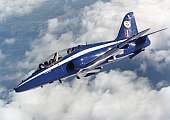
Blue Hawk T1, 1994
In 1994 92 Squadron was chosen to provide the RAF Hawk Solo Display for
the airshow season. The livery chosen harked back to 92's days as the
"Blue Diamonds" as well as giving a nod to the Red Arrows'
markings. Hawk T1 is put through its paces by Flt. Lt. Dave Stobie, display
pilot for the year. Dave went on to fly with the world famous Red Arrows.
Photograph: 92 Squadron via Ian Bowskill.
|
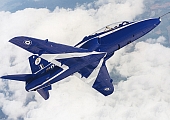
Blue Hawk T1, 1994
Flt. Lt. Dave Stobie putting Hawk T1 XX178 through its paces prior to the
1994 air display season.
Photograph: 92 Squadron via Ian Bowskill.
|
|
|
|
|
|
|
|
|
|
| Short Tucano |
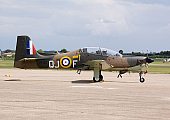
Tucano T1, 2010
As part of the Battle of Britain 70th anniversary celebrations the RAF
Tucano display aircraft have been painted in 1940s camouflage and adopted
squadron markings of the era.
Tucano T1 ZF317 wears 92 Squadron codes. QJ-F was flown by Brian Kingcombe who
was a leading pilot and Flight Commander with 92 during the Battle of Britain.
He also took temporary charge of the Squadron after the Squadron Leader was
incapacitated through injury.
Photograph: Ian Bowskill.
|
|
|
|
|
|
|
|
|















































































